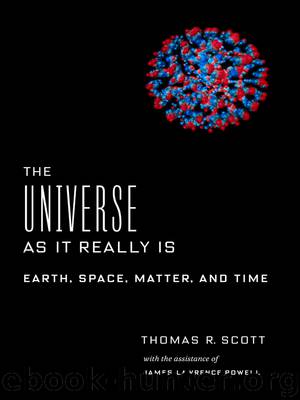The Universe as It Really Is by Thomas R. Scott

Author:Thomas R. Scott
Language: eng
Format: epub, azw3
Tags: SCI075000, Science/Philosophy & Social Aspects, SCI034000, Science/History
Publisher: Columbia University Press
Published: 2018-06-25T16:00:00+00:00
WEATHER FORECASTING
Few aspects of our natural world affect us as much as the weather, determining a range of future outcomes from whether you should plan to have a picnic tomorrow to whether your crops will thrive this season. Humans have tried to predict weather for millennia, mainly from atmospheric signals. From these observations arose the aphorisms of weather folklore32—often verbally catchy but with results not much better than chance predictions.
With the arrival of the telegraph in 1835, information on weather conditions could be sent across vast distances in an instant, so those experiencing a storm could warn others in its path. This advance in communications, combined with the invention of meteorological tools such as thermometers, barometers, and anemometers, gave forecasting a long-sought legitimacy. The density of information, its accuracy, and especially the computing power to process the resulting data have now extended reliable forecasts to as much as 10 days. The deployment of more collection sites that gather ever more precise data, the development of more sophisticated models, and the increased computing power to manipulate those models will continue to extend the period of accurate forecasts—predictions have already gone from 3 to 5, to 7, to 10 days in the past few decades. But the Farmers’ Almanac notwithstanding, reliability is unlikely ever to reach months, for the atmosphere is chaotic.
In 1961, meteorologist Edward Lorenz was using a computer model to make weather predictions. To shorten his work, he entered data point 0.506127 merely as 0.506. The outcome was altogether different. This became known as the butterfly effect: for example, a butterfly flapping its wings in Brazil could determine whether a tornado would strike Texas some weeks later. The butterfly did not cause the tornado any more than your great-great-grandfather’s particular sperm that won the egg race caused you to be reading this. But you would not be here without that unlikely event. The butterfly effect is a central tenet of chaos theory: nearly indistinguishable variations in the initial conditions, when amplified through a nonlinear system, might have exaggerated impacts on the outcome. So it is with Earth’s weather. The variables that impact daily events at any location are too numerous, too subtle, too widespread, and too unsuspected to be integrated into forecast models. Long-term climate changes may be foreseen; weather cannot.
Download
The Universe as It Really Is by Thomas R. Scott.azw3
This site does not store any files on its server. We only index and link to content provided by other sites. Please contact the content providers to delete copyright contents if any and email us, we'll remove relevant links or contents immediately.
Man-made Catastrophes and Risk Information Concealment by Dmitry Chernov & Didier Sornette(5921)
The Revenge of Geography: What the Map Tells Us About Coming Conflicts and the Battle Against Fate by Kaplan Robert D(4035)
Zero Waste Home by Bea Johnson(3777)
COSMOS by Carl Sagan(3554)
Good by S. Walden(3486)
In a Sunburned Country by Bill Bryson(3481)
The Fate of Rome: Climate, Disease, and the End of an Empire (The Princeton History of the Ancient World) by Kyle Harper(3003)
A Wilder Time by William E. Glassley(2818)
Camino Island by John Grisham(2762)
The Ogre by Doug Scott(2631)
Organic Mushroom Farming and Mycoremediation by Tradd Cotter(2626)
Human Dynamics Research in Smart and Connected Communities by Shih-Lung Shaw & Daniel Sui(2466)
Energy Myths and Realities by Vaclav Smil(2438)
The Traveler's Gift by Andy Andrews(2409)
9781803241661-PYTHON FOR ARCGIS PRO by Unknown(2321)
Inside the Middle East by Avi Melamed(2305)
Birds of New Guinea by Pratt Thane K.; Beehler Bruce M.; Anderton John C(2224)
A History of Warfare by John Keegan(2186)
And the Band Played On by Randy Shilts(2129)
